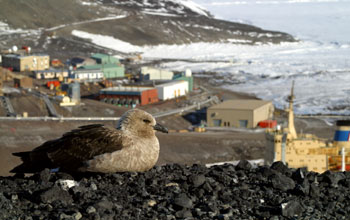Multimedia Gallery
South polar skua at McMurdo Station
A south polar skua ( Stercorarius maccormicki) sits on the Hut Point Ridge Trail, with McMurdo Station in the background. Polar skuas are the most southerly bird in the world. Although they live around the coastal edges of Antarctica, they have been seen flying over the South Pole, over 1,575 kilometers (850 miles) from the coast. They are large birds, measuring approximately 53 centimetres (21 inches) in length. McMurdo Station is one of three U.S. research stations on Antarctica. The National Science Foundation operates them all.
The National Science Foundation runs the U.S. Antarctic Program (USAP). In addition to maintaining three U.S. research stations on the continent, USAP supports research projects in an array of scientific disciplines, including for example, aeronomy and astrophysics, biology and medicine, geology and geophysics, glaciology, and ocean and climate systems. Outreach such as the Antarctic Artists and Writers program and education programs are also supported. For more information about USAP, visit the program's website Here. (Date of Image: February 2006)
Credit: Peter Rejcek, National Science Foundation
Images and other media in the National Science Foundation Multimedia Gallery are available for use in print and electronic material by NSF employees, members of the media, university staff, teachers and the general public. All media in the gallery are intended for personal, educational and nonprofit/non-commercial use only.
Images credited to the National Science Foundation, a federal agency, are in the public domain. The images were created by employees of the United States Government as part of their official duties or prepared by contractors as "works for hire" for NSF. You may freely use NSF-credited images and, at your discretion, credit NSF with a "Courtesy: National Science Foundation" notation.
Additional information about general usage can be found in Conditions.
Also Available:
Download the high-resolution JPG version of the image. (3.1 MB)
Use your mouse to right-click (Mac users may need to Ctrl-click) the link above and choose the option that will save the file or target to your computer.



